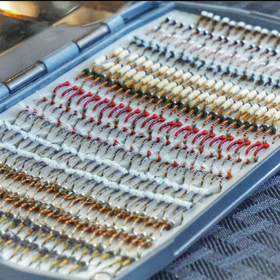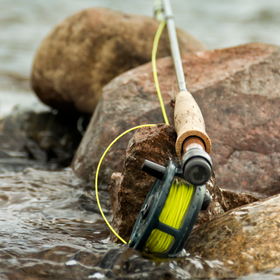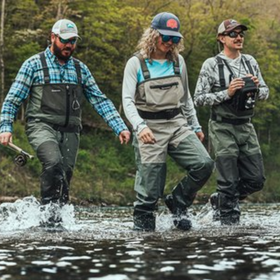The picturesque boulder-filled Cheesman Canyon portion of the South Platte River is considered by many one of the most pristine fisheries in the world. This area, often times simply referred to, as “the Canyon” is an experience you’ll never forget. It’s the perfect scenario, magnificent beauty in combination with great fly fishing. The South Platte River carves its way through a granite canyon lined with ponderosa pines, willows, fallen tree trunks, and various other assorted ground foliages. Boulders as big as Volkswagens Beetles create structure for the super-selective trout residing in the river. Mule Deer, Black Bear, Raccoons, Mountain Lyons, and Bald Eagles all add to the experience. Anglers can expect to catch mostly large rainbows supplemented with a few nice brown trout. The aforementioned “canyon” is as technical as they get, and if you can catch trout here, you can catch them anywhere in the world. This three-mile section is primarily a nymphing fishery requiring tiny midge and mayfly imitations with fine 5 and 6X tippets. Ideal flows for Cheesman Canyon are between 250 and 400 cfs. The regulations are flies and lures only. All fish must be returned to the water immediately. Cheesman Canyon is one of the best tailwaters in the country. There's a common belief among "canyon regulars" that if you can catch fish on the South Platte River, you can fool fish anywhere in the world. There's no substitution for good technique in Cheesman Canyon.
Updated 2/4/25
With the mild weather this week, bugs and fish are more active. That said, flows are 126 cfs coming out of Cheesman so stealth is still necessary as always during winter fishing. If you're not seeing many fish, keep covering water to find their winter lies where they tend to concentrate this time of year. Fly selection from our last update still applies.
Temps are looking nice the rest of the week, but there are some high winds in the forecast so keep that in mind if you're planning of fishing.
Updated 12/18/24
Flows have bumped to 173 cfs coming out of the dam. Now is the time to target the slow, deep pools where fish tend to hold this time of year.
Go small with the flies you choose for your rig. All midge, BWO-midge, or egg-midge combos are the way to go depending on what you see hatching.
Cheesman Canyon gets even more scenic during the winter, and anglers can be rewarded with willing fish -- for those willing to make the hike in. Winter midging here is the name of the game and can be downright excellant on some days. Most days during this season though, expect to work hard for each and every fish.
Here are some effective fly patterns to consider for wintertime fishing in this area:
Attractors: Eggs or small worms are typical go-to patterns throughout the winter. Try a size 18 Micro Egg.
Blue-Winged Olives (BWOs): Small BWOs hatch from Fall to early Winter, tapering off as temps get colder. Dor dries, carry Hif-Vis Baetis and Parachute Adams in sizes #22 to #24. For nymph, pheasant tails, Jujubaetis, RS2s, and foam wing emergers in the same sizes.
Midges: Midges are prevalent year-round and will be the only main staple throughout winter. Use patterns like Blood Midges, Black Beauties, and Pale Olive Larvas in sizes ranging from #22 to #24.
As always, observe the water conditions, insect activity, and the behavior of the fish to determine the most effective patterns and presentations. Adjust your techniques throughout the day as conditions change.
The shop staff and guides at The Blue Quill Angler are very familiar with Cheesman and can provide specific insights into recent hatches, successful patterns, and techniques tailored for winter fishing in the area. They often have firsthand knowledge that can greatly enhance your fishing experience.










